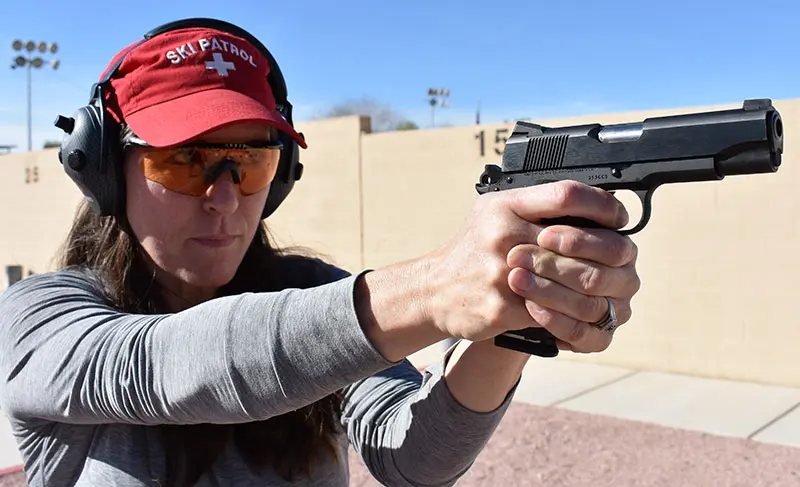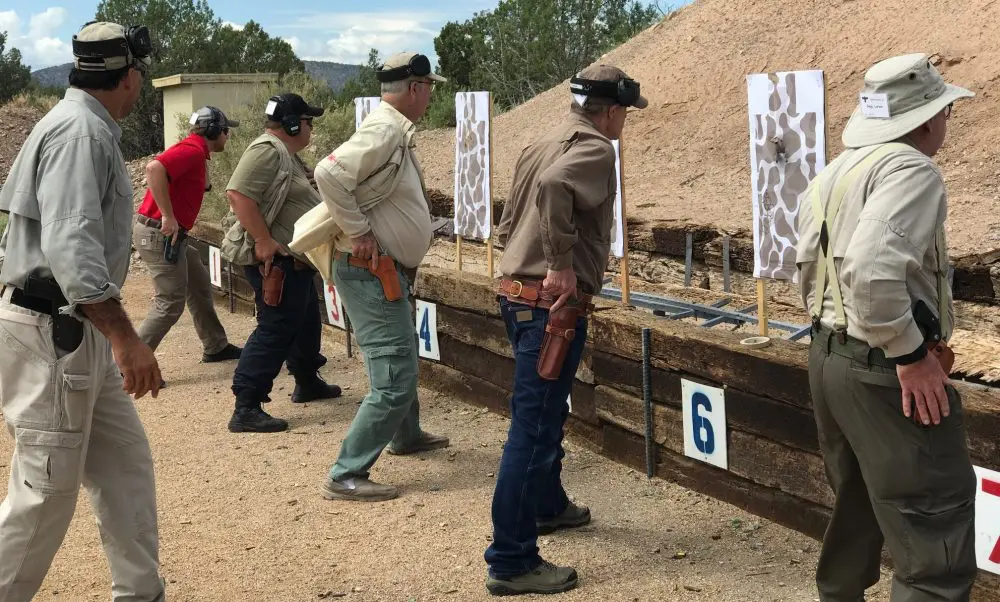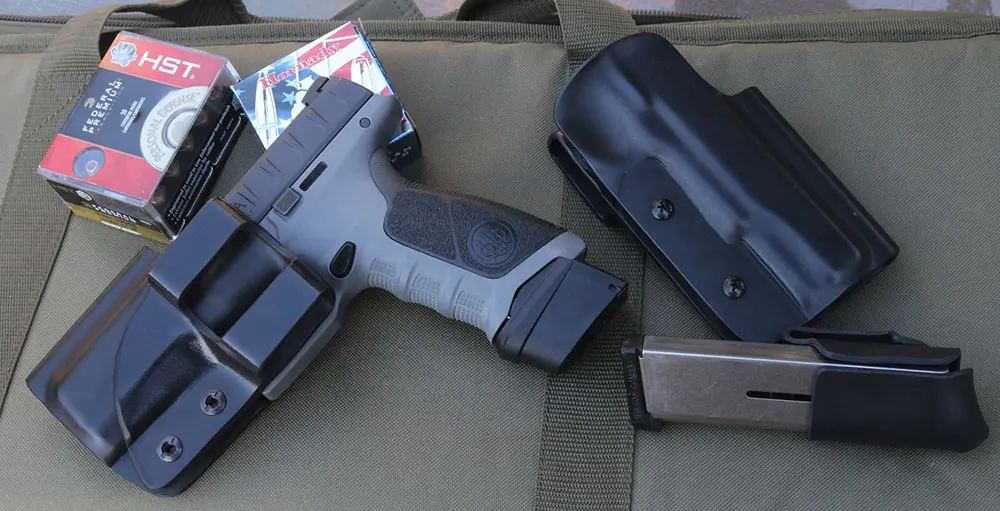“Think small, shoot small.”
If I had a dollar for every time I’ve heard that expression, I’d be sitting on a beach in the Bahamas, sipping umbrella-covered girlie-man drinks.
While it sounds like a brilliant idea in principle, sometimes when something walks like a duck and looks like a duck it turns out to be a Mallard. And despite the fact that the Think Small, Shoot Small concept may work for a minority percentage of shootists, for everyone else this thought process invariably exacerbates already existent problems—like oversize groups or low hits caused by yanking the trigger.
If it was such a good idea, why do most people shoot a smaller-sized group at the torso of a target than they do at the head of that target? Usually if it’s your inevitable ho-hum rectangular flat piece of cardboard, a relatively accomplished trigger-stroker will shoot quick four-to-six inch groups in the center of the chest of said target from generic five-to-ten yard distance markers.
However, once he’s asked to shoot a string of rounds between the running lights of the head portion of the target, the usual result is a couple of good hits, accompanied by one in the shoulder, and one or two entire misses, undoubtedly sliding past the cockpit of a terrified NASA space shuttle commander. Since Triggerman invariably takes more time for the bulleta en la cabeza, to ascertain a refined sight alignment/sight picture/trigger control triad on the smaller target, “think small, shoot small” obviously hasn’t exactly resulted in the personification of a roaring success in his case.
Since a one-dimensional piece of rectangular cardboard bears not the slightest resemblance to a human enemy, and since you aren’t facing any physical danger from the target, this is clearly merely a mechanical test of target-shooting ability. So why would you shoot a larger slow-fired group at a smaller target if the Think Small concept worked? Because it doesn’t work for most people, that’s why.
The problem lies within the gray mass the Creator saw fit to place inside a human head. Some people use it for thinking, others use it simply to keep their ears apart—and others misuse it and over-think a problem. Witness the same shootist trying to shoot his seven-yard, six-inch group at the torso from 25 yards, and he ends up with the same trashy net result as his six-yard head shots.
Ask him to make a two-second shot at a bowling pin 25 yards distant, and he magically shoots a six-to-eight inch group. Okay, one more time, shoot at the bowling pin—but this time hit it, even if it takes you half-an-hour. Result? Sometimes he hits it, but usually it’s a 20-inch group again. Apparently of all the $2,000 pistols guaranteed to shoot into one inch at 50 yards, you bought the only runt in the litter. Of course it only shoots large groups and/or left and low when a damned precision shot is required—must have something to do with that damned thingummybob they put in to reduce damned lock time after firing.
Damned gunsmiths. Damned ammunition manufacturers. Damned sun in your eyes. Damned boyfriend your daughter had ten years ago. Damned traffic laws. Obviously it has to be one of these damned things causing the problem, because you know it can’t be your own damned brain. Not Master Mensa, surely? Hate to tell you this, Mister Harvard graduate neurosurgeon, but you’re allowing yourself to be outwitted by a two-pound piece of metal that has the IQ of rocking-horse droppings.
And, of course, you insist on trying to “think small, shoot small.” That’s why that “ignorant peon” on the firing line next to you is still hitting at distance with his “inaccurate” snub-nosed revolver. It’s because he worked three jobs to pay his ailing mother’s medical bills, so he didn’t make it to university, so he doesn’t have the money for a one-inch-at-50-yards pimp pistol—or the “higher learning” to over-think a problem, which is exactly what you’re doing.
So snuggle up close and listen for the Grasshopper, because herewith is your problem—and how to fix it. You’re trying to shoot too accurately on precision targets.
What kind of idiotic statement is that? Well, since you’re the one with the shooting problem, and seeing that you’ve already waded through the preceding text, you may as well read the rest.
If you try for a perfect shot, you’ll wind up with garbage. Anybody who shoots air pistols will tell you that much. But if you go for 95 percent, you’ll be rewarded with at least 95 percent results. In other words, if you attempt to hit somebody exactly between his beady little eyes while firing a pistol from ten yards, you’ll attempt to “tell” the weapon when to fire, or you’ll unknowingly look for bullet impact before the projectile exits the gun barrel. This will result in either left-and-low hits for a right-handed shooter, and/or an erratic oversized group. The same thing will happen with a 25-yard torso shot. (In other words, any progressively smaller, or finite target.)
The solution is to pick an aiming point on which you can optically key in—such as the area between someone’s eyes—then make the target behind the key-in point as large as possible, and shoot center of mass of the larger target. To clarify: why shoot for a one-inch target between the parasite’s eyeballs when you realize that the one-inch target is located in the center of a six-by-six-inch head? A lot less brain drain and violation of basic mechanical shooting principles will be your reward if you merely shoot center of mass of the entire head.
That’s why the bowling pin example cited above works like it does. Mechanically, the shootist is capable of shooting a six-inch group from 25 yards distance. Ergo, if he “keys in” on the bowling pin and calmly shoots quickly, he will either hit it or impact extremely close to it. If he tries to actually hit it, he will often talk himself out of a decent shot.
Don’t believe it? Here’s your homework, kids. From the holster, one round, 25 yards, eight-inch target, two-and-a-half second time limit. Repeat 24 times (total 25 rounds). You’ll find out in a hurry that your two-pound pistol has a higher IQ than you do.
The sooner you “think large, shoot small,” the quicker your mechanical shooting will improve.
Trust me. I work for the Marksmanship Government and I’m just here to help you.
[Louis Awerbuck is director of the internationally acclaimed Yavapai Firearms Academy. Course information and schedules are available on their website at www.yfainc.com.]





